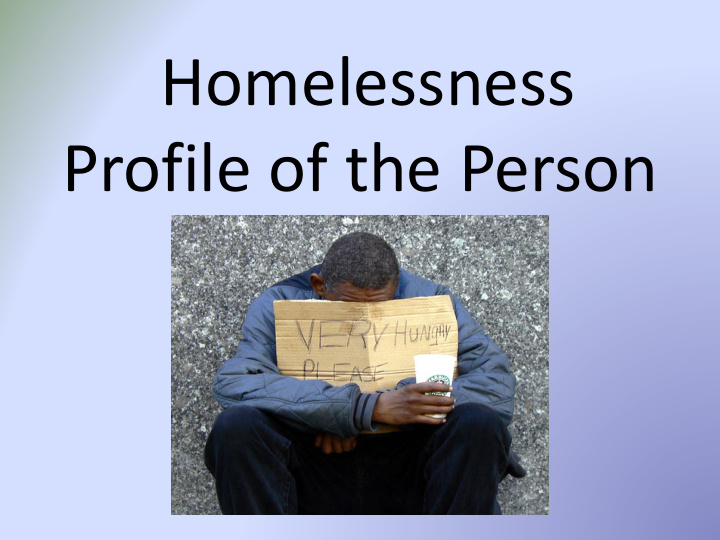



Homelessness Profile of the Person
Orange County Facts • 947.96 square miles • Smallest County in the State • Third most densely populated county with 3,010,232 people total. • Over 12,000 individuals homeless – 19% chronically homeless – Fragilely Housed
Background • Homeless today are defined as more ethnically diverse, younger, and are primarily unattached adult males and significantly greater numbers of women and children. • They are often thought of as “Drunk, Stoned, Crazy, and Sick”. • Also seen as riddled with “conspicuous dysfunctions.”
What’s Real? • Are there any flaws in the research? • Single encounter interviews allow only for strips of thoughts. • Resultant data: time bound and situation specific data that do not accurately portray the data. • Environmental Alley
Health Issues Physiological and Psychological Schizophrenia • Bipolar • Personality Disorders • Chronic diseases: Hypertension, Asthma, HIV, AIDS, Liver Disease, Cancer, Oral • Health, Skin Disease, TB. Generalized Panic Anxiety Disorders • PTSD (Post Traumatic Stress Disorders) • TBI (Traumatic Brain Injury) • Substance Abuse Disorders • Adaptive Behavior • Sleep Deprivation • Nutritional Deficiencies • Mortality Risks four times greater • Est. one third of homeless people are mentally ill •
Common Indicators Systemic Issues of Poverty • Disrupted Family arrangements (absentee father/mother) • Childhood insecurity (failure to bond, no role models, child conduct • disorders) Foster Care • Social Support Networks lacking • Physical Abuse/Sexual abuse • Lack of stable work history • Simply “Bad Luck” • Access to affordable housing • Downward spiral leads to loss of identity • School Failure •
Little Known Facts • Average age of Vietnam veteran 22 years versus 26 in WWII • Average age of Vietnam infantry men 19 years • One out of four homeless veterans are over fifty • Homelessness requires adaptive behavior similar to those experienced in war time activity • Transition plans for Vietnam veterans were not available due to unpopularity of the war • Homeless arrest rate is higher than majority of arrests, however, majority are for non-violent, relatively minor, and victimless offenses (documented research) • Homeless persons desire to have a voice in their description and present own story (documented research)
Barriers • Lack of affordable housing • Access to health care • Reagan Era policies
Real Cases Ted-welder ($95,000) year, stroke, no health coverage, loss job, housing, • savings depleted, living in car with wife. Daily in parks Employee Santa Fe Opera/Opera Pacific disabling health condition • contributed to loss of job, in and out hospitalizations, lost housing, motel destroyed his personal belongings, drug addicted, lives on street, shelter when available. Does not communicate with family. Male 46 years, bipolar PTSD. Teacher experienced violent campus activity • and threatened with life. Did not return to work ultimately lost job, apartment, medically comprised with asthma, seizure disorder, and GERD Ana, on parole, breast mass, severe anxiety panic disorder, lives in car as • she seeks care for cancer Anita/Jim married twenty three years, spiraling mental illness for Anita, • loss job, apartment, Jim now emotionally compromised, work in boiler room for cold calls, only help available for housing means separation. Sporadically live in motels, shelters, parks, business parking lots.
Recommend
More recommend